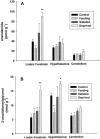Endocannabinoid levels in rat limbic forebrain and hypothalamus in relation to fasting, feeding and satiation: stimulation of eating by 2-arachidonoyl glycerol
- PMID: 12055133
- PMCID: PMC1573386
- DOI: 10.1038/sj.bjp.0704767
Endocannabinoid levels in rat limbic forebrain and hypothalamus in relation to fasting, feeding and satiation: stimulation of eating by 2-arachidonoyl glycerol
Abstract
Endocannabinoids are implicated in appetite and body weight regulation. In rodents, anandamide stimulates eating by actions at central CB1 receptors, and hypothalamic endocannabinoids may be under the negative control of leptin. However, changes to brain endocannabinoid levels in direct relation to feeding or changing nutritional status have not been investigated. We measured anandamide and 2-arachidonoyl glycerol (2-AG) levels in feeding-associated brain regions of rats, during fasting, feeding of a palatable food, or after satiation. Endocannabinoid levels were compared to those in rats fed ad libitum, at a point in their daily cycle when motivation to eat was absent. Fasting increased levels of anandamide and 2-AG in the limbic forebrain and, to a lesser extent, of 2-AG in the hypothalamus. By contrast, hypothalamic 2-AG declined as animals ate. No changes were detected in satiated rats. Endocannabinoid levels in the cerebellum, a control region not directly involved in the control of food intake, were unaffected by any manipulation. As 2-AG was most sensitive to variation during feeding, and to leptin regulation in a previous study, we examined the behavioural effects of 2-AG when injected into the nucleus accumbens shell, a limbic forebrain area strongly linked to eating motivation. 2-AG potently, and dose-dependently, stimulated feeding. This effect was attenuated by the CB1 receptor antagonist SR141716. These findings provide the first direct evidence of altered brain levels of endocannabinoids, and of 2-AG in particular, during fasting and feeding. The nature of these effects supports a role for endocannabinoids in the control of appetitive motivation.
Figures


References
-
- AMERI A. The effects of cannabinoids on the brain. Prog. Neurobiol. 1999;58:315–348. - PubMed
-
- ARNONE M., MARUANI J., CHAPERON F., THIEBOT M.H., PONCELET M., SOUBRIÉ P., LE FUR G. Selective inhibition of sucrose and ethanol intake by SR141716, an antagonist of central cannabinoid (CB1) receptors. Psychopharmacology. 1997;132:104–106. - PubMed
-
- BISOGNO T., BERRENDERO F., AMBROSINO G., CEBEIRA M., RAMOS J., FERNANDEZ-RUIZ J.J., DI MARZO V. Brain regional distribution of endocannabinoids: implications for their biosynthesis and biological actions. Biochem. Biophys. Res. Comm. 1999;256:377–380. - PubMed
-
- CARR K.D. Feeding, drug abuse, and the sensitisation of reward by metabolic need. Neurochem. Res. 1996;21:1455–1467. - PubMed
Publication types
MeSH terms
Substances
LinkOut - more resources
Full Text Sources
Other Literature Sources
Research Materials

